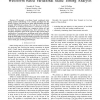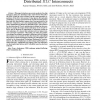26 search results - page 1 / 6 » The behavior of linear time invariant RLC circuits |
CDC
2010
IEEE
12 years 11 months ago
2010
IEEE
It is shown that just as we did for a purely resistive network [10], that circuit analysis is very simple if the elements are described not by potentials across and currents throug...
ICCAD
2003
IEEE
14 years 1 months ago
2003
IEEE
This paper presents an efficient method to reduce complexities of a linear network in s-domain. The new method works on circuit matrices directly and reduces the circuit complexi...
DATE
2007
IEEE
13 years 10 months ago
2007
IEEE
— We present a waveform based variational static timing analysis methodology. It is a timing paradigm that lies midway between convention static delay approximations and full dyn...
TCAD
2002
13 years 4 months ago
2002
This paper introduces an accurate analysis of on-chip inductance effects for distributed interconnects that takes the effect of both the series resistance and the output parasitic ...
ASPDAC
2004
ACM
13 years 8 months ago
2004
ACM
When time is incorporated in the specification of discrete systems, the complexity of verification grows exponentially. When the temporal behavior is specified with symbols, the ve...


